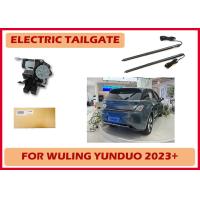Wuling Asta Smart Auto Car Electric Tail Gate Lift with Continental
Engineering Services
What is the electric tailgate?
An electric tailgate, also known as a power liftgate or automatic
tailgate, is a feature commonly found in modern vehicles that
allows the rear door or hatch to be opened and closed automatically
with the push of a button or through a sensor-based activation
system. It is typically powered by an electric motor and controlled
by the vehicle's electrical system.
The electric tailgate offers convenience to vehicle owners by
eliminating the need to manually open or close the rear door or
hatch. This feature is particularly useful when carrying heavy
items or when accessing the cargo area in situations where hands
may be occupied, such as when holding groceries or luggage.
The operation of an electric tailgate can vary depending on the
vehicle model and manufacturer. In most cases, the tailgate can be
opened or closed by pressing a button on the key fob, interior
control panel, or using a sensor-based system that detects foot
movement under the rear bumper. Some vehicles also provide
customizable height settings for the tailgate opening to
accommodate different parking spaces or user preferences.
In addition to the convenience factor, electric tailgates often
include safety features to prevent injury or damage. For example,
they may have sensors that can detect obstacles, such as a person
or object in the path of the closing tailgate, and automatically
reverse the operation to avoid accidents.

What is the mail parts of our electric tailgate?
The main parts of an electric tailgate include:
| Electric Motor: | Drives the opening and closing mechanism of the tailgate. |
| Control Module: | An electronic unit that processes inputs from controls and sensors
to operate the motor. |
| Sensors: | Includes proximity sensors and obstacle detection to ensure safe
operation. |
| Actuator: | Translates the motor's rotation into linear motion to lift or lower
the tailgate.
Hinges and Mechanical Linkages:
Connect the tailgate to the vehicle and allow for smooth movement. |
| Power Source: | Usually connected to the vehicle's battery, providing the necessary
power for operation. |
| User Interface: | Buttons on the key fob, dashboard, or foot-activated sensors for
user control. |
| Wiring Harness: | Connects all electronic components, allowing for communication and
power distribution. |

What is the technology of electric tailgate?
Electric tailgates are a feature commonly found in modern vehicles,
particularly SUVs and hatchbacks, enhancing convenience and
functionality. Here’s an overview of the technology behind them:
Key Components
Electric Motor: The heart of the system, responsible for opening
and closing the tailgate. It often includes a gear mechanism to
manage the movement smoothly.
Control Module: This electronic control unit processes signals from
various inputs (like remote key fobs, buttons inside the vehicle,
or proximity sensors) to operate the motor.
Sensors: Various sensors, including proximity sensors, allow the
tailgate to detect obstacles and prevent accidents during
operation. Some systems also feature automatic closing when a user
walks away.
Battery: The tailgate system is typically powered by the vehicle's
main battery, though some designs may include a backup battery.
User Interface: Controls for the electric tailgate can include
buttons on the key fob, dashboard, or even gestures (like
foot-activated sensors).
Functionality
Power Opening and Closing: Users can open or close the tailgate
with a button press or a remote control, providing hands-free
operation.
Height Adjustment: Some systems allow users to set a maximum
opening height, which is useful in garages with low ceilings.
Safety Features: Built-in safety measures prevent the tailgate from
closing if an object is detected in its path.
Benefits
Convenience: Makes loading and unloading easier, especially when
hands are full.
Accessibility: Ideal for individuals with mobility challenges or
when carrying heavy items.
Enhanced Security: Often integrated with the vehicle's security
system, offering an additional layer of protection.

















